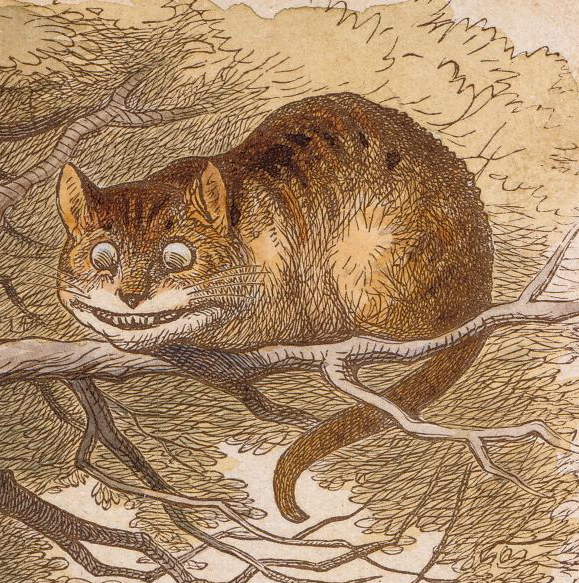My original title was going to be, “You Have Got to be High if You Think Lewis Carroll Could Write something like this High!,” but that was too long and a bit abrasive. But of course, that is subjective, which—would you look at that—is the perfect segue because Subjectivity is a theme I’d like to discuss from this book. I’ve noticed a trend of linking creativity to drug use, when the only real link between them is that the government discourages the use of both. As my almost-title so kindly says, I don’t think Lewis Carroll was on drugs while writing this book, what he did with his spare time is not important. This book is so articulate and packed with very interesting parallels that I will discuss.
I want to talk about subjectivity because that’s a major theme in this story. When you read this book and think, what the heck are they doing down there in wonderland, you’re actually pulling an Alice. She goes to this place where she is not from and labels things as normal or not, civil or not, never really taking in account WHO CARES WHAT SHE THINKS. She’s lost not because she’s a child but because she’s in a culture that is totally different from her. Reading this book now, it’s obvious that this tale is a criticque on western imperialism—but with the kiddie-bumpers up! Alice, you’re a child, you have an excuse; but no, not you, westernized civilization!
I feel it is his intention for us to read this and be, what I referred to as, “pulling an Alice” the whole time. He doesn’t have to be on any drug, but he must be on something to speak up against our values—that’s why it’s veiled as a child’s “adventure.” Take for example the Mad Tea-Party. Mad like crazy? …no, Alice.. Mad like everyone in Wonderland when you step on their way of life (“Mad” means something totally different to the inhabitants of Wonderland, and it does not have the same stigma attached to it as it does in westernized civilization). I like especially the part when the March Hare, Dormouse, and the Hatter all sit “crowded” at one corner and Alice comes around demanding and taking space for herself. Now sure, that table wasn’t completely covered up—or cultivated ;)—as well as Alice thought it should be, but it’s their table, it’s theirs, and she took it on her own…why is this all sounding so familiar? The exchange between Alice and the tea-party guests was very amusing:
‘Have some wine,’ the March Hare said in an encouraging tone.
Alice looked all round the table, but there was nothing on it but tea. ‘I don’t see any wine,’ she remarked.
‘There isn’t any,’ said the March Hare.
‘Then it wasn’t very civil of you to offer it,’ said Alice angrily.
‘It wasn’t very civil of you to sit down without being invited,’ said the March Hare.
‘I didn’t know it was your table,’ said Alice; ‘it’s laid for a great many more than three.’
‘Your hair wants cutting,’ said the Hatter. He had been looking at Alice for some time with great curiosity, and this was his first speech.
‘You should learn not to make personal remarks,’ Alice said with some severity; ‘it’s very rude.’
The Hatter opened his eyes very wide on hearing this….
Like how much faster does imperialistic thinking need to be shot down for this message to be any clearer. She is unable to be objective in a case that calls for just that. She is constantly judging everything she sees based off of her own experience and culture. Culture should not be viewed subjectively and that is what Lewis Carroll intended with his book, I feel. One thing will mean something totally different to someone else, and that’s ok.
So, when you think about it, it my post really late? because late sounds a bit subjective and what is Time really? Lewis Carroll really punched out quite a few ideals that are highly valued by our western civilizations. Reading this solely as a children’s book is a big mistake, and with the right emphasis this book could be a tool in educating our future generations—dare I be so subjective—correctly.
 My favorite character is the Cheshire cat. At first I was confused what a Cheshire was, so I looked it up and found it is defined by Mariam Webster as: Cheshire is a ceremonial county in North West England, in the United Kingdom. The western edge of the county forms part of England’s border with Wales. This concept of coming from another country could play into the whole idea if imperialism in Alice in Wonderland. The Cheshire cat has a huge grin on his face, and often poses philosophical questions to Alice. Carroll must have had a love for cats, because cats mentioned by Alice in the first chapter, as she has one herself, whom she loves. Cats represent mischievous charters in not literature.
My favorite character is the Cheshire cat. At first I was confused what a Cheshire was, so I looked it up and found it is defined by Mariam Webster as: Cheshire is a ceremonial county in North West England, in the United Kingdom. The western edge of the county forms part of England’s border with Wales. This concept of coming from another country could play into the whole idea if imperialism in Alice in Wonderland. The Cheshire cat has a huge grin on his face, and often poses philosophical questions to Alice. Carroll must have had a love for cats, because cats mentioned by Alice in the first chapter, as she has one herself, whom she loves. Cats represent mischievous charters in not literature.